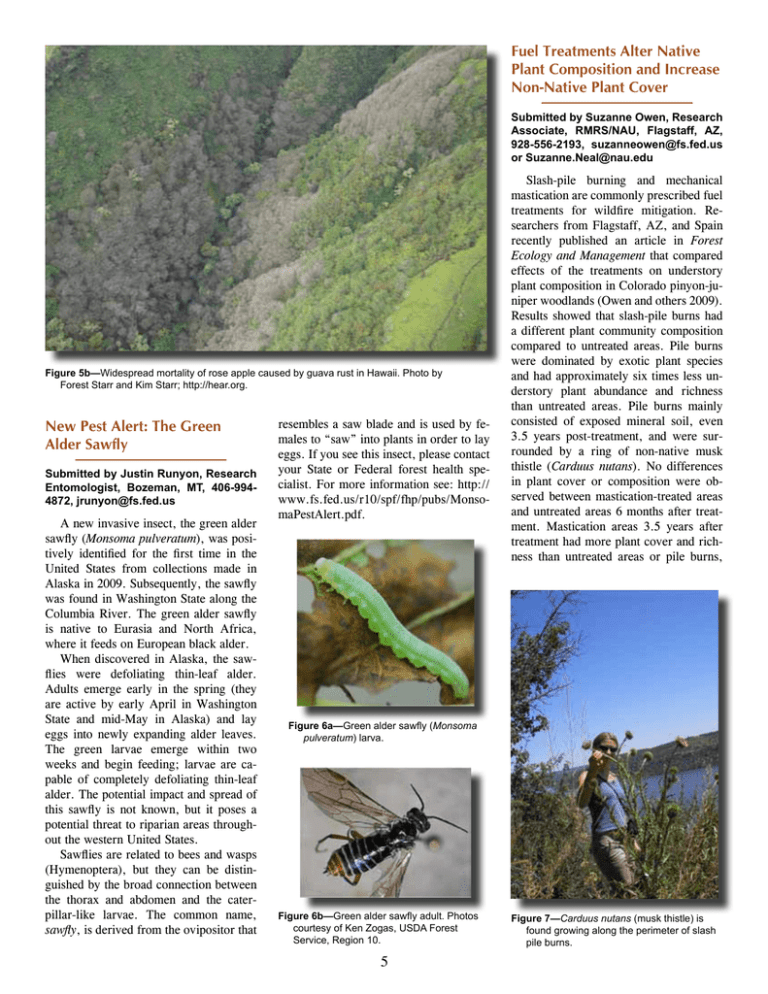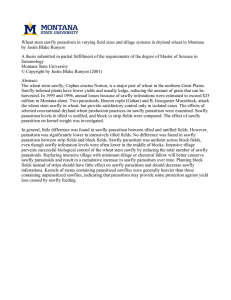Fuel Treatments Alter Native Plant Composition and Increase Non-Native Plant Cover
advertisement

Fuel Treatments Alter Native Plant Composition and Increase Non-Native Plant Cover Submitted by Suzanne Owen, Research Associate, RMRS/NAU, Flagstaff, AZ, 928-556-2193, suzanneowen@fs.fed.us or Suzanne.Neal@nau.edu Figure 5b—Widespread mortality of rose apple caused by guava rust in Hawaii. Photo by Forest Starr and Kim Starr; http://hear.org. New Pest Alert: The Green Alder Sawfly Submitted by Justin Runyon, Research Entomologist, Bozeman, MT, 406-9944872, jrunyon@fs.fed.us A new invasive insect, the green alder sawfly (Monsoma pulveratum), was positively identified for the first time in the United States from collections made in Alaska in 2009. Subsequently, the sawfly was found in Washington State along the Columbia River. The green alder sawfly is native to Eurasia and North Africa, where it feeds on European black alder. When discovered in Alaska, the sawflies were defoliating thin-leaf alder. Adults emerge early in the spring (they are active by early April in Washington State and mid-May in Alaska) and lay eggs into newly expanding alder leaves. The green larvae emerge within two weeks and begin feeding; larvae are capable of completely defoliating thin-leaf alder. The potential impact and spread of this sawfly is not known, but it poses a potential threat to riparian areas throughout the western United States. Sawflies are related to bees and wasps (Hymenoptera), but they can be distinguished by the broad connection between the thorax and abdomen and the caterpillar-like larvae. The common name, sawfly, is derived from the ovipositor that resembles a saw blade and is used by females to “saw” into plants in order to lay eggs. If you see this insect, please contact your State or Federal forest health specialist. For more information see: http:// www.fs.fed.us/r10/spf/fhp/pubs/MonsomaPestAlert.pdf. Slash-pile burning and mechanical mastication are commonly prescribed fuel treatments for wildfire mitigation. Researchers from Flagstaff, AZ, and Spain recently published an article in Forest Ecology and Management that compared effects of the treatments on understory plant composition in Colorado pinyon-juniper woodlands (Owen and others 2009). Results showed that slash-pile burns had a different plant community composition compared to untreated areas. Pile burns were dominated by exotic plant species and had approximately six times less understory plant abundance and richness than untreated areas. Pile burns mainly consisted of exposed mineral soil, even 3.5 years post-treatment, and were surrounded by a ring of non-native musk thistle (Carduus nutans). No differences in plant cover or composition were observed between mastication-treated areas and untreated areas 6 months after treatment. Mastication areas 3.5 years after treatment had more plant cover and richness than untreated areas or pile burns, Figure 6a—Green alder sawfly (Monsoma pulveratum) larva. Figure 6b—Green alder sawfly adult. Photos courtesy of Ken Zogas, USDA Forest Service, Region 10. 5 Figure 7—Carduus nutans (musk thistle) is found growing along the perimeter of slash pile burns. Science Notes cont. although non-native cheatgrass (Bromus tectorum) cover was also greater. Mastication is the preferred short-term method because it causes fewer disturbances to understory plant communities than pile burning; however, long-term impacts of mastication warrant further study as this practice could increase the cover of cheatgrass, an especially problematic exotic species. Results suggest that the manner in which woody debris is treated following tree thinning has an important influence on native plant biodiversity. New Publications Highlight Invasive Weed Research Submitted by Dean Pearson, Research Ecologist, Missoula, MT, 406-542-4159, dpearson@fs.fed.us New papers by Pearson, Ortega, and other team members include information on the ecology and management of invasive weeds, the effects of persistence and retreatment intervals on residual herbicide impact, the politics of funding biocontrol research, and the effects of invasive weeds on native predator-prey communities. • Pearson and Ortega (2009) describe the issues of weed ecology and management based on their extensive study of the spotted knapweed invasion in western Montana. • Pearson (2009a) describes issues related to the ecology and management of biological invasions on oceanic islands. • Crone and others (2009) quantify side effects of a broadleaf herbicide treatment for spotted knapweed on native arrowleaf balsamroot demography. • Maron and others (2010) describe how funding affects research on biocontrol of weeds. • Pearson (2009b) examines the subtle but extensive and complex effects of invasive weeds on higher trophic levels of native species by simply changing vegetation architecture. Figure 8a—Field trip to Chilbadlo Island. From left: Dr. Hee-Young Chae, Director of the Korean National Park Research Institute; Dr. Jong Min Kim, Senior Researcher at the Korean National Institute of Environmental Research; Dr. Chung Il Choi, Vice-Chair, UNESCO Man and the Biosphere Programme; and Dean Pearson, Research Ecologist, RMRS. Figure 8b—Korean scientists assess Swinhoe’s storm-petrels killed by the invasive Japanese chaff flower (Achyranthes japonica) on Chilbaldo Island. Invasive Weeds Trap and Kill Birds on Islands in South Korea Submitted by Dean Pearson, Research Ecologist, Missoula, MT, 406-542-4159, dpearson@fs.fed.us Although native to East Asia, Japan, and some large islands around Japan, Japanese chaff flower is invasive on several seabird islands off the coast of Korea. The plant kills petrels by ensnaring them within entangling seedheads. Adults are trapped when they return to their burrows to feed their young, which soon parish for lack of parental care. The plants also appear to reduce habitat for burrows. Research Ecologist Dean Pearson, Missoula, recently gave the keynote address to the 3rd International Symposium on Migratory Birds in Mokpo, South Korea. In his presentation titled Seabirds in Danger: Invasive Species and Conservation of Island Ecosystems, he described the unique attributes of island ecosystems that influence invasiveness and invasive species management. The symposium speakers from the United States, Russia, Spain, New Zealand, Australia, Japan, and South Korea toured the island biosphere reserve of Shinan County. They also consulted with South Korean scientists and the Korea National Park Service employees who are establishing invasive species management programs to protect diverse and fragile island ecosystems. 6 Combining Soil Disturbance Monitoring with Invasive Species Monitoring Submitted by Deb Page-Dumroese, Research Soil Scientist, Moscow, ID, 208883-2339, ddumroese@fs.fed.us With revision of the Forest Soil Disturbance Monitoring Protocol (PageDumroese and others 2009a and 2009b), the presence of invasive species can now be more efficiently recorded during field surveys. At the request of the National Figure 9—A researcher prepares to collect soil monitoring data.






